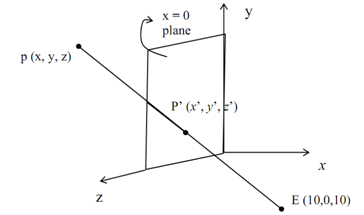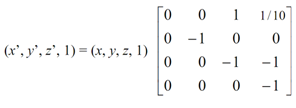Consider the line segment AB in 3-Dimentional parallel to the z-axis along with end points A (- 5,4,2) and also B (5,-6,18). Carry out a perspective projection upon the X=0 plane; here the eye is placed at (10, 0,10).
Solution: Suppose here that P (x, y, z) be any point in the space.
The parametric equation of a line beginning from E and passing via P is: E + t. (P - E), o < t < 1.
= (10,0,10) + t. [(x, y, z) - (10, 0, 10)]
= (10, 0,10) + t [(x - 10)], y (z - 10)]
= (t. (x - 10) + 10, t. y, t (z - 10) + 10)
Suppose a point P' can be obtained, as t = t*
∴P' = (x', y', z') = (t* (x - 10) + 10, t*.y, t*. (z - 10) + 10)
Because the point P' lies on x = 0 plane as:

Figure: (j)
= t* (x - 10) + 10 = 0
= t* =(- 10)/ (x - 10)
= P' = (x',y',z') = (0,((-10.y)/(x - 10)),(((-10)(z - 10))/(x - 10)), + 10)
(0, ((-10.y)/(x - 10)),((10x - 10z)/(x - 10)))
In terms of Homogeneous coordinate system;
P' = (x', y', z', 1) = ( 0, ((-y )/((x - 10) - 1)) , (x -z)/((x/10) - 1)), 1)
= (0, -y, x-z, ((x/10) - 1))
In Matrix form there is:

-------------------------(1)
In above equation (1) is the needed perspective transformation, that gives a coordinates of a projected point P' (x', y', z') on the x = 0 plane, whereas a point p (x, y, z) is viewed from E (10, 0, 10)
Currently, for the specified points A (-5, 4, 2) and B (5, -6, 18), A' and B' are their projection upon the x = 0 plane.
So now from Equation (1) we get:

= (0,-4, -7, ((-5/10) - 1))
= (0 , -40, -70, -15)
(0, 40/15, 70/15, 1)
Thus x1' = 0; y1' = 2.67 ; z1' = 4.67
As the same in:

= (0, 60, - 130, - 5)
= (0, - 12, 26, 1)
Thus x2' = 0 ; y2' = - 12 ; z2' = 26
Hence the projected points A' and B' of specified points A and B are:
A' = (x1', y1'z1') = (0, 2.67, 4.67) and B' = (x2', y2', z2') = (0, - 12, 26, 1)